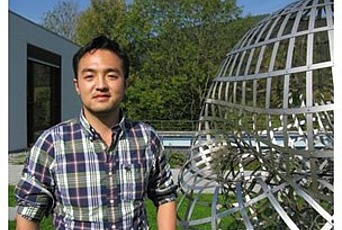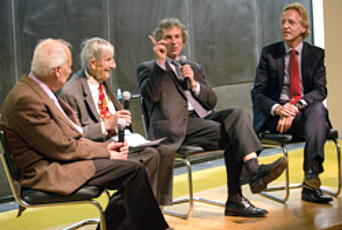My Search for Ramanujan

In November, out of the blue, I received a letter from the Institute for Advanced Study in Princeton. Nothing about the envelope suggested that the letter inside would be important. It was an ordinary white office envelope with Institute for Advanced Study as the return address. It could have been an announcement of the seminar schedule for all I knew. But it was much more than that. I was like the boy Charlie from Roald Dahl’s children’s book Charlie and the Chocolate Factory when he tore the wrapper off his Wonka bar to discover the last of five golden tickets, offering a tour of the magical factory and a lifetime supply of chocolate. Instead of all the chocolate I could ever want, I had been given an even sweeter prize. The letter was from the renowned number theorist and Fields medalist Enrico Bombieri. It consisted of a single paragraph offering me a two-year membership at the Institute. Andrew Granville had recommended me to Bombieri, praising my goal of searching for Ramanujan’s number theory, and Bombieri had apparently found my goal worthy of support. I had only one duty—to pursue my search for Ramanujan. The letter was a dream come true. I would have the privilege of working at an institution made famous by the likes of Einstein, Dyson, Gödel, Oppenheimer, and Weil, among many other luminaries.
And of course, the Institute had played a special role in my family history. André Weil, who had discovered my father in Japan forty years earlier, was a longtime faculty member. Over the years, he had arranged several visiting positions for my father, including the 1968–1969 academic year, the year I was born. My mother would take long walks on the Institute campus, pushing me in a carriage. Erika and I would have our first child, Aspen, at the Institute in 1996, and history would almost repeat itself: instead of long walks pushing a carriage, Erika and I would glide around the grounds on roller blades with Aspen strapped safely in a pink baby jogger.
Thanks to the strong support of my mentors Paul Sally, Basil Gordon, and Granville, I had somehow reached a level beyond my wildest dreams. I had dropped out of high school ten years earlier, and four years later, my complex analysis professor at the University of Chicago had tried to talk me out of pursuing a doctorate. Now I was pursuing my own research program at the Institute for Advanced Study. And woven through all that history was my faithful guide Ramanujan.
My decision to search for Ramanujan the mathematician would mean going a bit more distance out of my way. I wanted to increase my knowledge, and that would slow down my publication rate, something that anyone trying to land a permanent job must take into account. The Institute’s offer was therefore a godsend. I could concentrate on my mathematics in an environment free of other distractions and responsibilities; I had access to world-class libraries at the Institute and Princeton University, and I would be able to learn from some of the world’s most brilliant and talented mathematicians. I vowed to make the most of this special opportunity.
Erika and I moved to Princeton in August 1995, my third consecutive August move. We lived in a two-bedroom Bauhaus apartment at 69 Einstein Drive. Erika found work as a nurse in Trenton, and I did my number theory research. My first task was to complete my web of modularity. After that initial investment, I would then turn to my search for Ramanujan’s mathematics.
The 1995–1996 academic year at the Institute was devoted to an examination of the proof of Fermat’s last theorem. Although it turned out that the original proof by Wiles had a flaw, he was able to correct it in a supplementary paper written with his former graduate student Richard Taylor. Due to the importance of their work, the Institute had invited many of the world’s leading number theorists to spend the year in a collaborative environment in which they could push number theory even further. It was an awesome year, one that would contribute to my growth as a mathematician and help my career in many ways. With so many experts to talk to, I was able to complete the bulk of the work for my web of modularity in good order.
We made many friends that year, mostly other young mathematicians. Two of our closest friends were Princeton graduate students Kannan “Sound” Soundararajan and Chris Skinner. Sound would later become a professor at Stanford, and Chris would become a professor at Princeton. We were fans of the TV show X-files, and we made frequent trips to nearby Iselin, New Jersey, for Indian food. Chowpatty was our favorite restaurant, and that is where I developed a taste for south Indian vegetarian dishes like pav bhaji and masala dosa.
My enthusiasm for cycling rubbed off on Chris and Sound. I helped them shop for mountain bikes, and we rode often on the trails in the area, even after one of us flipped over the handlebars on a narrow and rocky descent and landed in the emergency room. When our daughter Aspen was born in June 1996, Chris and Sound became her first “uncles.”
I wrote papers with Chris and Sound during my Princeton years. Chris and I would ultimately write three papers on mathematics related to the Birch- Swinnerton-Dyer conjecture, one of the notorious “Millennium Problems” whose solution would bring a million-dollar prize. This was part of filling in my web, the groundwork I felt was necessary before I could begin my search for Ramanujan’s mathematics in earnest.
When I wasn’t thinking about that problem, Ramanujan’s words were on my mind, as if he were somehow speaking to me. In addition to his comments about the absence of further “simple properties” for the partition numbers, I was deeply interested in a 1916 paper on quadratic forms in which similar puzzling words appeared, this time about the absence of a “simple law.” Sound and I became enamored with the problem implied by Ramanujan’s words. We had to figure out what he meant. . . .
There seemed to Ramanujan to be no simple law that would explain his list and show how it continues. What did he mean that there doesn't appear to be a "simple law"?
Quadratic forms are objects that mathematicians have studied for centuries. One of the most famous theorems about them is due to the eighteenth-century mathematician Joseph Lagrange. He proved that every positive integer—no exceptions!—can be expressed as the sum of four perfect squares. It’s like a magic trick: Pick a number, any number. How about 374? Then I can pull four integers out of my hat such that their squares add up to 374. For example, 374 = 02 + 22 + 92 + 172. I could also have written 374 = 62 + 72 + 82 + 152 (as you can see, there is nothing necessarily unique about such representations). Lagrange proved that there is nothing special about 374. You can find a similar representation for every positive integer.
Now in solving a mathematical problem, it is crucial to ask the question in a way that leads to a solution. So instead of asking whether every positive integer can be written as a sum of four squares, Lagrange considered the quadratic form a2 + b2 + c2 + d2 and proved that by plugging in all possible integer combinations for a, b, c, d into that quadratic form, you obtain all of the numbers l, 2, 3, 4, ... .
In the 1916 paper that had intrigued Sound and me, Ramanujan was considering the quadratic form x2 + y2 + 10z2, in relation to which he wrote, “the odd numbers that are not of the form x2 + y2 +10z2, viz., 3, 7, 23, 31, 33, 43, 67, 79, 87, 133, 217, 219, 223, 253, 307, 391 ... do not seem to obey a simple law.” Whereas Lagrange’s quadratic form could represent every positive integer, there are numbers that cannot be written in the form x2 + y2 + 10z2 (the reader can easily verify that the numbers in Ramanujan’s list above cannot be thus represented).
There are plenty of odd numbers that can be obtained by this quadratic form, such as 57 = 12 + 42 + 10 x 22, where we have chosen x = l, y = 4, and z = 2. There seemed to Ramanujan to be no simple law that would explain his list and show how it continues. What did he mean that there doesn’t appear to be a “simple law”?
In 1990, Bill Duke and Rainer Schulze-Pillot proved a fantastic theorem that implied that all odd numbers from some point on must be represented in this way. That meant that Ramanujan’s list petered out eventually, since the number of odd integers that cannot be represented by the quadratic form in question is finite. You could say, then, that Ramanujan was right: there was no simple law. Indeed, you could say that there was no law at all! It was just a finite list of the relatively few (however many it might be, a finite number is small compared to infinity) integers that happened not to have such a representation. On the other hand, for us, the law that we had to find was this: what is the last number on the list? And was finding it going to be simple, or was it going to be hard?
Sound and I ran a computer program, and we found that Ramanujan’s list could be extended by the odd numbers 679 and 2719. But after that, the well ran dry. For every larger odd number we tried—and we tried all the way up to the super-huge number l,000,000,000,000,000—we found that it could be expressed by the quadratic form using some choice of x, y, and z. We concluded that we had found the “from some point on” from Duke and Schulze-Pillot’s theorem. That was the “simple law.” It must be true that every odd number larger than 2719 can be expressed by Ramanujan’s quadratic form, and we set out to prove it. Although we firmly believed that we were right, we couldn’t come up with a proof, no matter how hard we tried. When mathematicians are unable to prove something that they believe to be true, they sometimes are able to give a proof on the assumption that some unproven conjecture is true. In our case, we were able to prove that 2719 is the last number in the sequence on the assumption of the truth of the generalized Riemann hypothesis.
The ordinary Riemann hypothesis is one of the most important open problems in mathematics. It involves a certain conjectured property of a certain function of a complex variable. Its truth would resolve many unanswered questions. For example, mathematicians would have a much clearer understanding of prime numbers if the Riemann hypothesis were confirmed to be true. The generalized Riemann hypothesis is a natural generalization of the Riemann hypothesis.
Using a long and complicated argument, we finally found a way to show that the truth of the generalized Riemann hypothesis implies that every odd number greater than 2719 can be written as x2 + y2 + 10z2 for some integers x, y, and z. The fact that almost every mathematician believes in the truth of the generalized Riemann hypothesis and the fact that every odd number greater than 2719 up to a very large number can be represented by Ramanujan’s quadratic form convinced us that we had found the law. But although the law is simple enough to state, it thus far defies a definitive proof. To be sure, if someone manages to prove the generalized Riemann hypothesis, then our conditional proof will at once become a genuine proof. But the generalized Riemann hypothesis is arguably one of the most difficult open problems in mathematics. So Ramanujan was right that the odd numbers do not obey a simple law, in the sense that they are constrained by one of the most difficult unsolved problems in mathematics.
I had no idea that I would see the number 2719 again ten years later, etched on a wall in the very spot where Ramanujan performed some of his first calculations.
Thanks to my two years in Princeton, I was able to complete a large body of work, and I was rewarded for my efforts with a tenure-track assistant professorship at Penn State University. George Andrews, one of the mathematicians I admired from the BBC documentary and Robert Kanigel’s book The Man Who Knew Infinity, had recommended me for the position. My work on Ramanujan’s mathematics, namely my work on Mathukumali Subbarao’s conjecture for the partition numbers and my work with Sound on Ramanujan’s quadratic form, were the reasons for my success.


